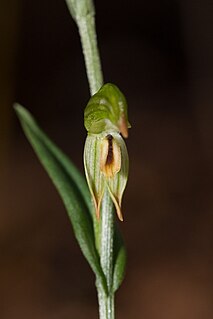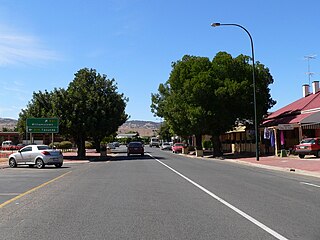
Pterostylis chlorogramma, commonly known as the green-striped leafy greenhood, is a plant in the orchid family Orchidaceae and is endemic to Victoria. Flowering plants have up to seven translucent green flowers with darker green stripes. The flowers have a green labellum with a darker stripe down the middle. Non-flowering plants have a rosette of leaves on a short, thin stalk but flowering plants lack the rosette, instead having five to seven stem leaves.

Pterostylis cobarensis, commonly known as the inland rustyhood or Cobar rustyhood is a plant in the orchid family Orchidaceae and is endemic to Australia. It has a rosette of leaves and between two and ten hairy, green and brown flowers with translucent white "windows" and a fleshy, insect-like labellum. It grows in inland areas of eastern Australia.

Pterostylis jonesii, commonly known as the montane leafy greenhood, is a plant in the orchid family Orchidaceae and is endemic to a small area of south-eastern Australia. Individual plants have either a rosette of three to six leaves or a flowering spike with up to eleven flowers and five to seven stem leaves. The flowers are translucent green with faint darker green lines and have a brownish-yellow labellum with a dark stripe.
Pterostylis brumalis, commonly known as the kauri greenhood or winter greenhood, is a species of orchid endemic to New Zealand. There is a rosette of leaves at the base of both flowering and non-flowering plants. Flowering plants have a white flower with narrow green stripes and a dorsal sepal which bends forward strongly while the petals spread widely, giving the flower a cobra-like appearance.
Pterostylis commutata, commonly known as the midland rustyhood is a plant in the orchid family Orchidaceae and is endemic to Tasmania. It has a rosette of leaves near its base and up to five translucent white and green flowers with a hairy, insect-like labellum. It is only found in a small area near Tunbridge and Ross.
Pterostylis frenchii, commonly known as the tuart rufous greenhood, or tuart rustyhood is a plant in the orchid family Orchidaceae and is endemic to the south-west of Western Australia. Both flowering and non-flowering plants have a relatively large rosette of leaves. Flowering plants also have up to twelve white and green or white and brown flowers which lean forward and have a small, fleshy, insect-like labellum.
Pterostylis ferruginea, commonly known as the Bangham rustyhood, is a plant in the orchid family Orchidaceae and is endemic to the border area between South Australia and Victoria. It has a rosette of leaves and when flowering, up to ten upright, dark green and translucent white flowers which have an insect-like labellum.
Pterostylis gibbosa, commonly known as the Illawarra rustyhood, or Illawarra greenhood, is a plant in the orchid family Orchidaceae and is endemic to New South Wales. It has a rosette of leaves at its base and up to nine bright green flowers with translucent "windows", relatively wide lateral sepals with short-pointed tips and a dark, fleshy, insect-like labellum.
Pterostylis insectifera, commonly known as the insect-lipped rufous greenhood, or leaden rustyhood is a plant in the orchid family Orchidaceae and is endemic to the south-west of Western Australia. Both flowering and non-flowering plants have a relatively large rosette of leaves. Flowering plants have a similar rosette and up to eight or more flowers which have long, stiffly-held lateral sepals and a protruding, insect-like labellum.
Pterostylis lepida, commonly known as the Halbury greenhood is a plant in the orchid family Orchidaceae and is endemic to South Australia. Both flowering and non-flowering plants have a rosette of leaves. Flowering plants have up to ten green flowers with brown and translucent striations and a small, insect-like labellum. It is only known from two small populations.
Pterostylis macrocalymma, commonly known as the large-hooded rufous greenhood or Murchison rustyhood is a plant in the orchid family Orchidaceae and is endemic to the south-west of Western Australia. Both flowering and non-flowering plants have a relatively large rosette of leaves. Flowering plants also have up to ten or more white flowers with bold green or pale brown lines and a broad spoon-shaped, insect-like labellum.
Pterostylis macrosceles, commonly known as the slender rufous greenhood is a plant in the orchid family Orchidaceae and is endemic to the south-west of Western Australia. Both flowering and non-flowering plants have a relatively large rosette of leaves. Flowering plants also have between four and eight white flowers with green brown lines and small, insect-like labellum. It is distinguished from other Western Australian greenhoods by the unusually long thread-like tips on its sepals.
Pterostylis macrosepala is a plant in the orchid family Orchidaceae and is endemic to New South Wales where it grows on the central-west slopes. As with similar greenhoods, the flowering plants differ from those which are not flowering. The non-flowering plants have a rosette of leaves flat on the ground but the flowering plants have up to eight translucent green flowers with narrow, dark green stripes and up to ten stem leaves.
Pterostylis roensis, commonly known as the painted rufous greenhood or dark rustyhood is a plant in the orchid family Orchidaceae and is endemic to the south-west of Western Australia. Both flowering and non-flowering plants have a relatively large rosette of leaves. Flowering plants also have up to six green or brown to blackish flowers with translucent white panels and a dark brown, fleshy, insect-like labellum.
Pterostylis saxicola, commonly known as the Sydney plains rustyhood, or Sydney plains greenhood, is a plant in the orchid family Orchidaceae and is endemic to New South Wales. It has a rosette of leaves at its base and up to ten reddish-brown flowers with translucent "windows", relatively wide lateral sepals with short-pointed tips and a dark brown, fleshy, insect-like labellum.
Pterostylis stenosepala, commonly known as the narrow-sepalled leafy greenhood, is a plant in the orchid family Orchidaceae and is endemic to New South Wales. Flowering plants have up to six shiny, translucent green flowers with darker green stripes. The flowers have an insect-like labellum which is green with a dark green mound on its upper end. Non-flowering plants have a rosette of leaves on a stalk, but flowering plants lack the rosette, instead having between four and eight stem leaves.
Pterostylis vernalis, commonly known as the spring tiny greenhood, is a species of orchid endemic to New South Wales. As with similar orchids, the flowering plants differ from those that are not currently flowering. Non-flowering plants have a rosette of leaves at the base. Flowering plants lack that rosette, but have one or two rosettes on lateral growths. The flowers are green, brown and white. This greenhood is only known from a small area near Nowra.
Pterostylis xerophila, commonly known as the desert rustyhood, is a plant in the orchid family Orchidaceae and is endemic to South Australia. Both flowering and non-flowering plants have a relatively large rosette of leaves. Flowering plants also have up to eight translucent white, green and reddish-brown flowers with an insect-like labellum.
Pterostylis exserta, commonly known as the exserted rufous greenhood, is a species of orchid endemic to the south-west of Western Australia. Both flowering and non-flowering plants have a large rosette of leaves flat on the ground and flowering plants have up to seven pale, transparent green and white flowers with brownish lines.
Pterostylis flavovirens, commonly known as the coastal banded greenhood, is a plant in the orchid family Orchidaceae that is endemic to South Australia. As with other similar orchids, non-flowering plants differ from those in flower. Flowering plants have up to seven pale to translucent green flowers with darker green stripes. The flowers have an insect-like labellum which is yellowish green with a slightly darker green stripe along its centre. Non-flowering plants have a rosette of leaves on a stalk, but flowering plants lack the rosette, instead having three to six stem leaves.













